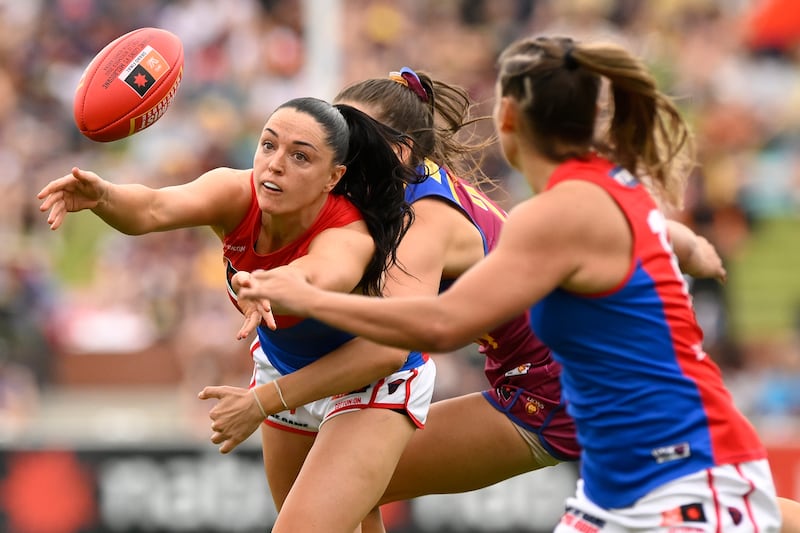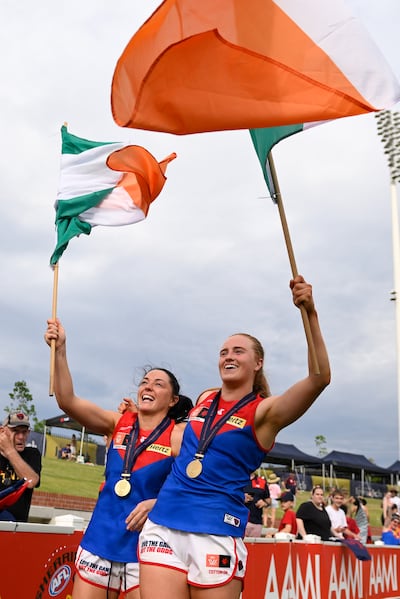In August, Disney+ released the AFLW series Relentless, following a number of teams through the highs and lows of an AFLW season. Bríd Stack of the GWS Giants was the primary Irish representative, charting her journey, which started with an almost career-ending neck injury, and taking in the story of how sport and motherhood coexisted for her, a topic which is rarely covered.
Relentless mapped last season, which saw Ailish Considine and the Adelaide Crows capture their second title. This season, there was a whole new Irish contingent in Australia, hungry for success.
At the centre of it is Mike Currane, the Irish Aussie Rules coach responsible for funnelling many of the Irish players currently Down Under to the AFLW. And with two new winners – in Armagh’s Blaithin Mackin and Dublin’s Sinéad Goldrick of the Melbourne Demons – Mike was at the final to witness the fruits of the collaborative labour come together.
[ Joanne O’Riordan: When it comes to nurturing women in sport, Aussies ruleOpens in new window ]
“It’s been an amazing experience across the last two weeks. I work closely with the Irish AFLW players (current and future) and the AFLW clubs on an ongoing and continuous basis, but nothing beats getting down to Oz and around to the various clubs and seeing everyone face to face,” he explains.
Irish WWE star Lyra Valkyria: ‘At its core, we’re storytellers. Everything comes down to good versus evil’
Ken Early on World Cup draw: Ireland face task to overcome Hungary, their football opposites
The top 25 women’s sporting moments of the year: 25-6 revealed with Mona McSharry, Rachael Blackmore and relay team featuring
Is there anything good about the 2034 World Cup going to Saudi Arabia?
“It’s been a couple of years since I’ve been able to do something due to Covid. Even some clubs have added amazing new facilities or expanded their AFLW facilities since I was last there. The facilities available at every club now to the female players are outstanding.”
The new collective bargaining agreement (CBA) has ensured steps towards parity on some levels, and the average player salaries have increased 94 per cent across the board. In a new tiered system, Tier 1 players will receive $71,935 (€46,766), which previously was $37,155; Tier 4 players will receive $39,184, which was previously $20,239. The result? More interest from players, higher commitment levels and rising standards.
From an Irish perspective, that could mean more talent departing Irish shores. Currane admits more players want to give it a go.

“At this very early stage of planning for 2023, it’s looking like somewhere close to 10 new players I am working with could be signed for next season. There’s a long way to go, but that would be an early indication. Combining this with the Women’s World Cup next June or July, there could be a raft of elite Irish female athletes in Australia at the one time competing at the highest level in multiple sports.”
[ Next three years could see Irish involvement in AFLW peak and then fallOpens in new window ]
With opportunities to play abroad in a semi-professional game and avenues to explore life as a professional athlete, it’s only reasonable to expect that some will move.
“Well, I think it’s always been attractive for the reasons that most of the 28 Irish players that have been signed to date would say, getting to play as a professional and in a professional environment and competition. Of course, the recent pay increases as per the last CBA have made it very comfortable for the Irish players and all the players in general, with some of them on even better contracts. This is only set to improve as the competition expands across the next few seasons to fully professional”, explains Currane.

In Relentless, we saw how the former Giants coach, Alan McConnell, constantly asked Bríd Stack and co-captain Cora Staunton how the club’s mentality needed to change. The strength and conditioning era is driving standards in ladies’ football and camogie. While camogie changed the rules to allow for some physicality, ladies’ football seems stuck in thinking women will break if touched. So, naturally, when phenomenally physical athletes like Goldrick, Mackin, Vikki Wall and Erika O’Shea are excelling, it’s interesting to see how Irish players are leading from the front.
“There were 22 players in total this season, 10 Players playing finals, six playing preliminary finals, and of course three playing in the Grand Final, with two medals coming back to Ireland via Sinéad and Blaithin, I’d venture to say the Irish players are a major contributor and driver of the rising standards. Every coach and club I met across the last couple of weeks – and I got to meet almost all of them – will say that their Irish players set and drive the standard at training and off the oval around the clubs, not alone at games.”
[ Nobody has done more to funnel Irish players to the AFLW than Mike CurraneOpens in new window ]
And that’s while playing a new sport that was pretty much alien to them a few years ago.
“It’s brilliant to see the players in situ at the clubs and getting to work. Everyone single one of them are amazing ambassadors for Ireland. I knew they would be amazing on an international stage, but it’s heartwarming to see them on the ground.
“The Irish players are excelling in the current semi-pro set-up (with most of them effectively pro by virtue of not having other jobs outside football, bar a few part-time hours within other areas of the club for some). They are all performing at the top level and are among the top players at each club. We see the likes of Aileen Gilroy finishing second in the Hawthorn Best and Fairest, Aish Mac second in the West Coast Best and Fairest, Áine Tighe third in Fremantle.”
“They are adored by fans at every club, their team-mates, and all the staff. I’m super proud, and everyone at home should be too.”






